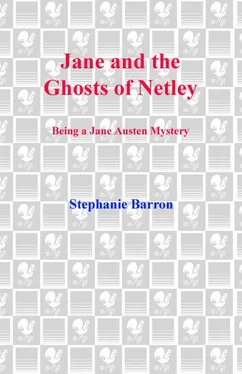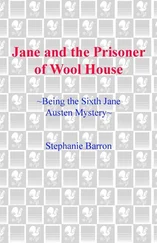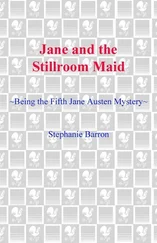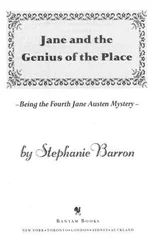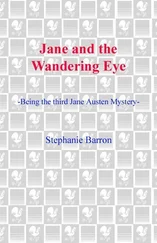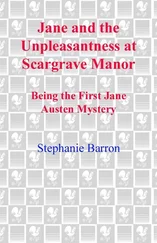Stephanie Barron - Jane and the Ghosts of Netley
Здесь есть возможность читать онлайн «Stephanie Barron - Jane and the Ghosts of Netley» весь текст электронной книги совершенно бесплатно (целиком полную версию без сокращений). В некоторых случаях можно слушать аудио, скачать через торрент в формате fb2 и присутствует краткое содержание. Жанр: Исторический детектив, Иронический детектив, на английском языке. Описание произведения, (предисловие) а так же отзывы посетителей доступны на портале библиотеки ЛибКат.
- Название:Jane and the Ghosts of Netley
- Автор:
- Жанр:
- Год:неизвестен
- ISBN:нет данных
- Рейтинг книги:4 / 5. Голосов: 1
-
Избранное:Добавить в избранное
- Отзывы:
-
Ваша оценка:
- 80
- 1
- 2
- 3
- 4
- 5
Jane and the Ghosts of Netley: краткое содержание, описание и аннотация
Предлагаем к чтению аннотацию, описание, краткое содержание или предисловие (зависит от того, что написал сам автор книги «Jane and the Ghosts of Netley»). Если вы не нашли необходимую информацию о книге — напишите в комментариях, мы постараемся отыскать её.
rings true as always.
Jane and the Ghosts of Netley — читать онлайн бесплатно полную книгу (весь текст) целиком
Ниже представлен текст книги, разбитый по страницам. Система сохранения места последней прочитанной страницы, позволяет с удобством читать онлайн бесплатно книгу «Jane and the Ghosts of Netley», без необходимости каждый раз заново искать на чём Вы остановились. Поставьте закладку, и сможете в любой момент перейти на страницу, на которой закончили чтение.
Интервал:
Закладка:
10
Recusant was the label applied to those British subjects who refused to swear an oath of allegiance to the Church of England, and thus to its secular head, the Crown. Included in this group were a variety of sects, but the term was generally taken to denote Roman Catholics, whose allegiance was accorded to the pope. As a result of refusing to swear the oath, English Catholics of Austen’s era were barred from taking degrees at either Oxford or Cambridge, holding cabinet positions or seats in Parliament, serving as commissioned officers in either the army or the navy, or entering the professions as physicians, lawyers, or clergy. They were thus consigned to the roles of leisured gentry or merchants in trade. They were forbidden, moreover, to educate their children in their chosen faith — and thus frequently sent school-age progeny to France for instruction. — Editor’s note.
11
From this reference to a housemaid named Phebe, it would seem that the Austens’ faithful servant Jenny, who had been with them since 1803, had left their service. — Editor’s note.
12
Jane probably refers, here, to the manuscript versions of Northanger Abbey (Susan), Pride and Prejudice (First Impressions), Sense and Sensibility (Elinor and Marianne), and Lady Susan . She had also begun, and abandoned, a novel entitled The Watsons by 1807. — Editor’s note.
13
The Company of Shipwrights incorporated in 1605.— Editor’s note.
14
The passage Lord Harold describes still exists at Netley Abbey today. — Editor’s note.
15
The custom of going into black clothes at the death of a relative increased during the Victorian era, which made an elaborate ceremony of mourning; but in Austen’s day, it was customary to honor only the closest relations with prolonged adoption of black. A spouse might adopt mourning clothes for half a year or longer, but more distant relations would shorten the period and the degree of black clothing, wearing merely black gloves or hair ribbons in respect of the most distant family members. — Editor’s note.
16
Maria Fitzherbert was born Maria Anne Smythe on 26 July 1756 in Jane Austen’s own county of Hampshire. Her mother was the halfsister of the Earl of Sefton; her paternal grandfather, a baronet created by Charles II in gratitude for loyal Catholic support during the Civil War. She thus belonged firmly among the Recusant Ascendancy, as noble Catholics were called. — Editor’s note.
17
La Belle Assemblée, despite its title, was not a French ladies’ periodical but a British one, subtitled Bell’s Court and Fashionable Magazine. It was printed in London and contained numerous fashion plates with descriptions of materials, trims, and appropriate accessories, for both men and women. It was common to carry such engravings to one’s modiste when ordering a gown. — Editor’s note.
18
The guinea was a unit of currency that was often used for the cost of expensive items, such as horses, carriages, and certain items of clothing. A guinea connoted twenty-one shillings — one shilling more than a pound. Thus, the cost of Jane’s costume — though hardly exorbitant by the standards of the day — amounted to eight shillings more than her yearly income. By contrast, a good hunter could command seven hundred guineas at Tattersall’s Auction Room. — Editor’s note.
19
The Gordon Riots occurred in 1780 when Lord George Gordon moved that a petition protesting Roman Catholic influence on public life be taken into immediate consideration by Parliament. In response, Protestant mobs burned Catholic chapels and looted Catholic property over a period of a week; Newgate Prison was stormed and its prisoners liberated; the killed and wounded number 458. Lord George was tried and acquitted of High Treason as a result. — Editor’s note.
20
Catholic Emancipation, or the Irish Question, as it was sometimes called, erupted throughout the final years of George III’s reign as a result of the inclusion of Irish representatives among the members of the unified Westminster Parliament from 1801. Those Irish members who were also Catholic were “debarred” from taking their seats under the provisions of the British constitution. The Whig opposition, and even some Tories such as William Pitt the Younger, raised the necessity of “emancipating” Catholics, or according them the full rights of all British subjects, but George III refused even to consider the question, because as king he had sworn to uphold the Church of England. Catholic Emancipation was finally passed by the Duke of Wellington’s administration in 1829. — Editor’s note.
21
Lord Harold refers to the Duke of Devonshire, regarded at this time as the grey eminence of the Whigs. — Editor’s note.
22
Frank Austen refers to Robert Stewart, Viscount Castlereagh (1769–1822), secretary for war in the Percival government. Castlereagh reorganized the army, creating a disposable force of 30,000 for use at short notice, with dedicated sea transport. He was one of Sir Arthur Wellesley’s oldest friends, and valued Wellesley’s advice on matters military. He is famed for having fought a duel with his fellow minister, Foreign Secretary Robert Canning; he committed suicide in 1822, a year after succeeding his father to the title of Marquess of Londonderry. — Editor’s note.
23
A gentleman’s carte blanche was his promissory note — offered to a woman he supported as a mistress, guaranteeing complete funding at her discretion. — Editor’s note.
24
The term “monsignor” now refers to a specific rank of seniority within the church hierarchy, and is only rarely applied to members of the Jesuit order — specifically, when a Jesuit is designated a monsignor by the local bishop. In Austen’s day, however, monsignor — or monseigneur, as it was variously spelled — was an honorific or term of respect applied to persons of rank throughout Europe, whether ordained or not. — Editor’s note.
25
Founded by Basque nobleman Ignatius of Loyola in 1540, the Society of Jesus came to be regarded as an army devoted to the Papacy, and thus as a threat to temporal kingdoms and power. It was expelled from Portugal, Spain, and their overseas possessions between the years of 1759 and 1768; it was also outlawed in France. In 1773, Pope Clement XIV suppressed the order under pressure from the Bourbons, and many Jesuits fled Europe to join their brethren in the American colonies. By 1814, however, Pius VII had revoked the brief of suppression and restored the Society of Jesus. — Editor’s note.
26
It was common practice in Austen’s day for the coroner’s panel to view the corpse at an inquest. — Editor’s note.
27
Jane Leigh-Perrot, the wife of Mrs. Austen’s brother, James LeighPerrot, was accused of shoplifting by a Bath merchant in 1799. She was held in Ilchester gaol for seven months, tried for a capital crime, and, had she been convicted, faced transportation to Australia or public execution — all for a card of lace. She was acquitted but remained subject to rumors of kleptomania ever after. — Editor’s note.
Читать дальшеИнтервал:
Закладка:
Похожие книги на «Jane and the Ghosts of Netley»
Представляем Вашему вниманию похожие книги на «Jane and the Ghosts of Netley» списком для выбора. Мы отобрали схожую по названию и смыслу литературу в надежде предоставить читателям больше вариантов отыскать новые, интересные, ещё непрочитанные произведения.
Обсуждение, отзывы о книге «Jane and the Ghosts of Netley» и просто собственные мнения читателей. Оставьте ваши комментарии, напишите, что Вы думаете о произведении, его смысле или главных героях. Укажите что конкретно понравилось, а что нет, и почему Вы так считаете.
